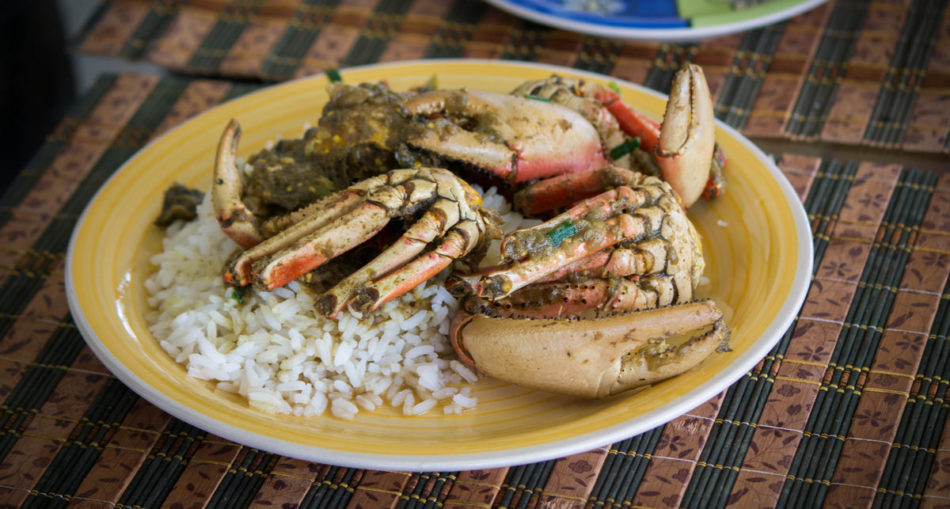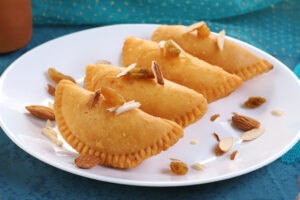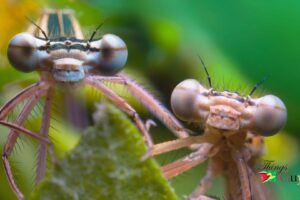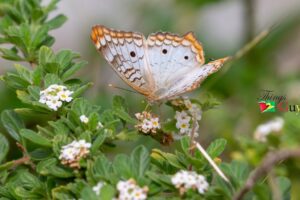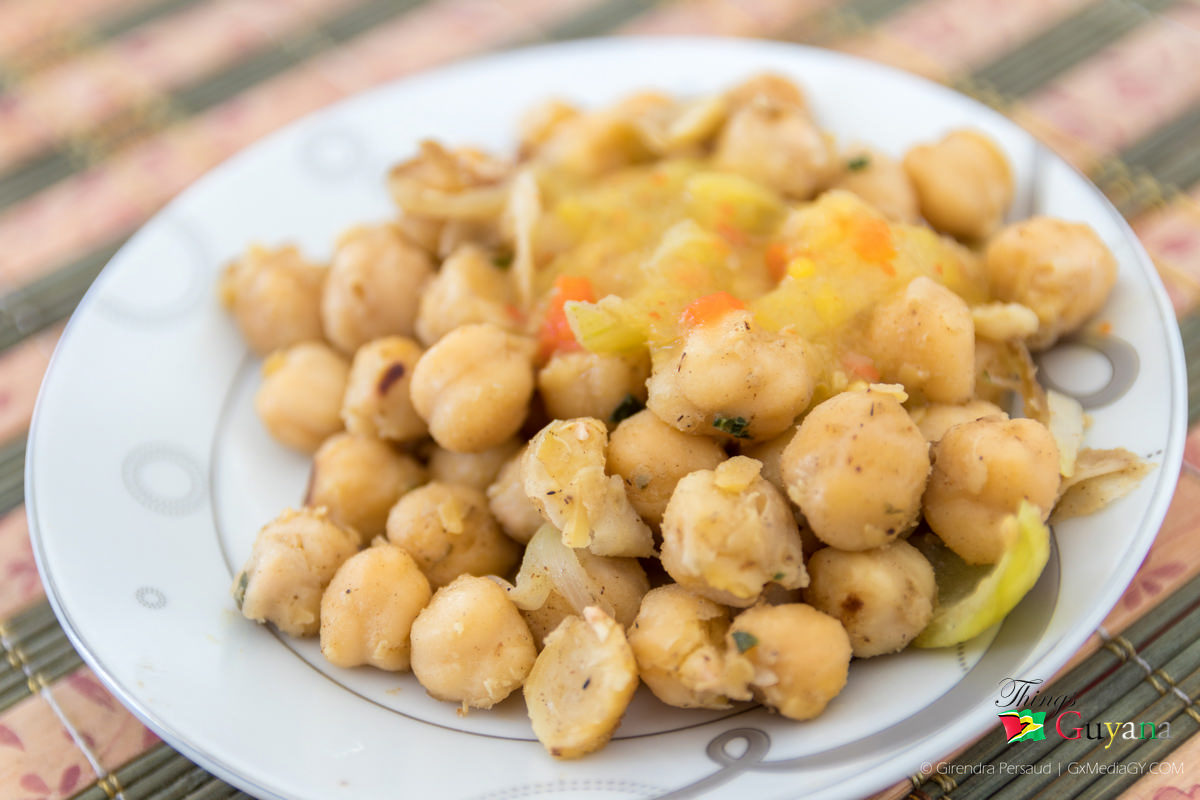Crabs live in all the world’s oceans; you will find them in fresh water and on land. They are generally covered with a thick exoskeleton and have a single pair of pincers. Crabs are decapod crustaceans of the infraorder Brachyura, which typically have a very short projecting “tail” (abdomen), usually hidden entirely under the thorax. This article will reveal three types of crabs found in Guyana as well as a finger-licking crab curry recipe.
Crabs live in all the world’s oceans; you will find them in fresh water and on land. They have a thick exoskeleton and one pair of pincers. Crabs are decapod crustaceans of the infraorder Brachyura, which have a short tail, usually hidden entirely under the thorax. This article will reveal three species of crabs found in Guyana as well as a finger-licking crab curry recipe.
Tip: The most popular crabs found in Guyana are the bunduri, bok and sherriger.

A lad selling crabs at Mahaica Market.
The Bunduri Crab
The bunduri is a very large, blue crab and you will find them in the North West District and the Essequibo Coast. During the mating season between late August and early September, when there is a spring tide, they go on a “march” and would literally cover the entire beach along the Atlantic Ocean. It is indeed an amazing sight to see these huge crabs go on their march. In the past, you would’ve only seen them on the seaside or along river banks but because they have increased in number, you would now see them climbing hills, sandlots and even in person’s backyards.
The Bok Crab
The most popular of the three species is called the bok crab. Bok crabs are red in colour and are a bit smaller compared to the bunduri crabs. In addition, they have tiny little hairs all over their legs. The flesh of this crab can be used to make “crab backs” a popular cafe delicacy. To make crab backs you need to clean and scrub the crabs. Crab cakes are another speciality made.
The Sherriger Crab
Sherriger is another well-known crab in Guyana. It is a water crab and lives mostly in inland lakes, trenches, and rivers. It is a great swimmer using its flattened and fringed legs as paddles. The claws and shell (back) have sharp points at the ends. Its colour varies from green, black, grey, reddish-brown to scarlet. Some are caught in the trench by using a saltfish tail or the innards of a chicken, as bait tied to a string. The string with the bait is let down into the trench and its movement indicates the sherriger had grabbed the bait and was trying to eat it. The string is then pulled up slowly and as soon as the crab appears to be clinging to the bait, a mokra basket cover or small seine is pushed under it and the sherriger is flipped to the roadside.
How Crab Is Sold In Guyana
The crab is caught and packed in barrels or straw baskets and transported to Georgetown for sale in the main markets – Stabroek, Bourda, La Penitence and Kitty. They are sold by the strings, six on a string or 10 for $1000 gyd, depending on the season. The claw of each is tied with a straw string and the string is then tied to nails on top the circular edge of the wooden barrel. The customer inspects the various strings and makes his or her selection. Amazingly, the crabs would try to crawl over each other’s back to reach the top of the barrel to escape. The bunduri and bok is a speciality for crab curry, sometimes for crab soup with eddo, callaloo, cassava and plantain, and for boiled crab.
Fun Fact: There is a popular saying in Guyana, “Yuh behaving like crab in a barrel.” This means you’re pulling your fellow man down while trying to get to the top.
Cooking Crab In Guyana – The Famous Crab Curry
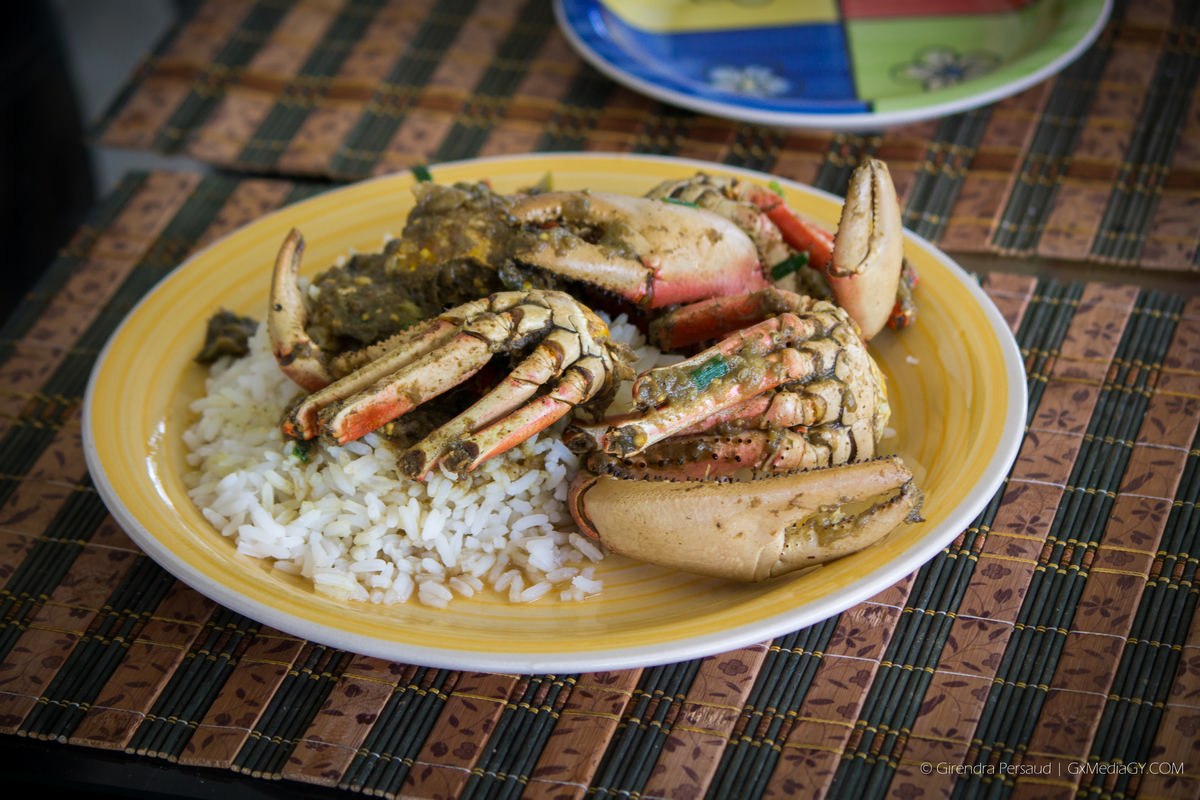
Crab Curry Guyanese Style
Ingredients:
- 8 large crabs, cleaned and split in half
- 3/4 cup water
- 2 tbsp green seasoning
- 3 tablespoons curry powder
- 1 1/2 cups coconut milk
- 3 tablespoons cooking oil
- salt to taste
- 2 wire wiri peppers
Method
- Make a curry paste with curry powder, green seasoning.
- Heat oil and cook the paste.
- Add in the crabs, salt and pepper.
- Stir in the coconut milk and allow the cook for 20 minutes.
- Remove from heat and serve.
Catching Crabs In Guyana
The catching of Crabs requires patience and precision The job can mostly be done at nights when the crab is supposed to be in its hole and not roaming around in the darkness searching for food. You then push your hands in the hole and grab the back of the crab. By putting a bright light near the hole, it causes the crab to leave and get caught. The best time to catch crabs is during the “crab march” where they gather in large numbers for the mating season.Crabs are also caught in the nets of fishermen and can be cooked in a variety of ways. See also: https://www.thingsguyana.com/crab-catching-time/
Article References:
- https://guyaneseonline.net/2014/01/06/crabs-of-guyana-south-pacific-by-peter-halder/
- https://en.wikipedia.org/wiki/Crab
- http://jehancancook.com/2015/10/coconut-crab-curry/
- https://meroza.wordpress.com/2008/10/19/guyanese-recipes-2/
- https://en.wikipedia.org/wiki/Crab_mentality
Last Updated: 2020-07-20

